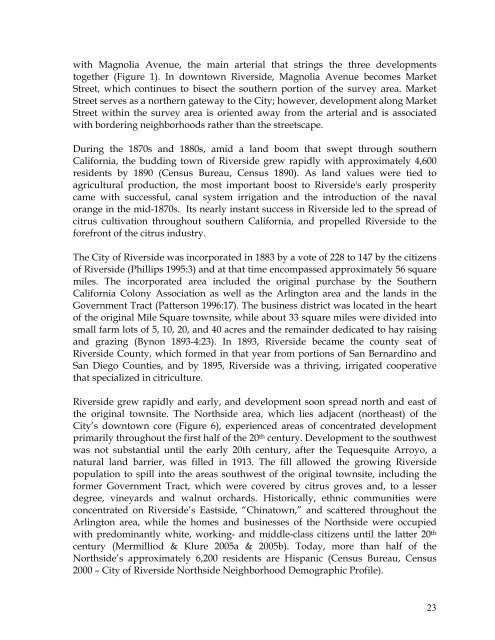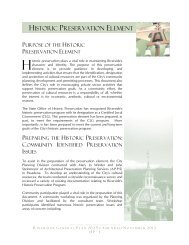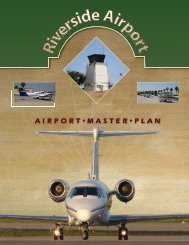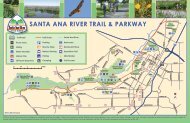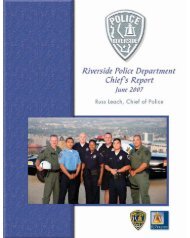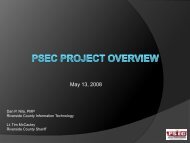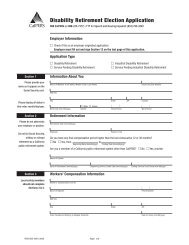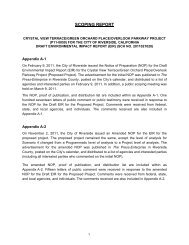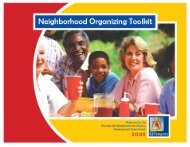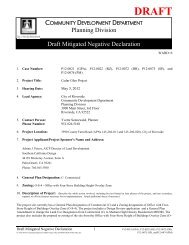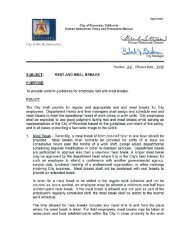Northside - City of Riverside
Northside - City of Riverside
Northside - City of Riverside
You also want an ePaper? Increase the reach of your titles
YUMPU automatically turns print PDFs into web optimized ePapers that Google loves.
with Magnolia Avenue, the main arterial that strings the three developments<br />
t ogether (Figure 1). In downtown <strong>Riverside</strong>, Magnolia Avenue becomes Market<br />
Street, which continues to bisect the southern portion <strong>of</strong> the survey area. Market<br />
Street serves as a northern gateway to the <strong>City</strong>; however, development along Market<br />
Street within the survey area is oriented away from the arterial and is associated<br />
with bordering neighborhoods rather than the streetscape.<br />
During the 1870s and 1880s, amid a land boom that swept through southern<br />
California, the budding town <strong>of</strong> <strong>Riverside</strong> grew rapidly with approximately 4,600<br />
residents by 1890 (Census Bureau, Census 1890). As land values were tied to<br />
agricultural production, the most important boost to <strong>Riverside</strong>'s early prosperity<br />
came with successful, canal system irrigation and the introduction <strong>of</strong> the naval<br />
orange in the mid-1870s. Its nearly instant success in <strong>Riverside</strong> led to the spread <strong>of</strong><br />
citrus cultivation throughout southern California, and propelled <strong>Riverside</strong> to the<br />
forefront <strong>of</strong> the citrus industry.<br />
The <strong>City</strong> <strong>of</strong> <strong>Riverside</strong> was incorporated in 1883 by a vote <strong>of</strong> 228 to 147 by the citizens<br />
<strong>of</strong> <strong>Riverside</strong> (Phillips 1995:3) and at that time encompassed approximately 56 square<br />
miles. The incorporated area included the original purchase by the Southern<br />
California Colony Association as well as the Arlington area and the lands in the<br />
Government Tract (Patterson 1996:17). The business district was located in the heart<br />
<strong>of</strong> the original Mile Square townsite, while about 33 square miles were divided into<br />
small farm lots <strong>of</strong> 5, 10, 20, and 40 acres and the remainder dedicated to hay raising<br />
and grazing (Bynon 1893-4:23). In 1893, <strong>Riverside</strong> became the county seat <strong>of</strong><br />
<strong>Riverside</strong> County, which formed in that year from portions <strong>of</strong> San Bernardino and<br />
San Diego Counties, and by 1895, <strong>Riverside</strong> was a thriving, irrigated cooperative<br />
that specialized in citriculture.<br />
<strong>Riverside</strong> grew rapidly and early, and development soon spread north and east <strong>of</strong><br />
the original townsite. The <strong>Northside</strong> area, which lies adjacent (northeast) <strong>of</strong> the<br />
<strong>City</strong>’s downtown core (Figure 6), experienced areas <strong>of</strong> concentrated development<br />
primarily throughout the first half <strong>of</strong> the 20 th century. Development to the southwest<br />
was not substantial until the early 20th century, after the Tequesquite Arroyo, a<br />
natural land barrier, was filled in 1913. The fill allowed the growing <strong>Riverside</strong><br />
population to spill into the areas southwest <strong>of</strong> the original townsite, including the<br />
former Government Tract, which were covered by citrus groves and, to a lesser<br />
degree, vineyards and walnut orchards. Historically, ethnic communities were<br />
concentrated on <strong>Riverside</strong>’s Eastside, “Chinatown,” and scattered throughout the<br />
Arlington area, while the homes and businesses <strong>of</strong> the <strong>Northside</strong> were occupied<br />
with predominantly white, working- and middle-class citizens until the latter 20 th<br />
century (Mermilliod & Klure 2005a & 2005b). Today, more than half <strong>of</strong> the<br />
<strong>Northside</strong>’s approximately 6,200 residents are Hispanic (Census Bureau, Census<br />
2000 – <strong>City</strong> <strong>of</strong> <strong>Riverside</strong> <strong>Northside</strong> Neighborhood Demographic Pr<strong>of</strong>ile).<br />
23


